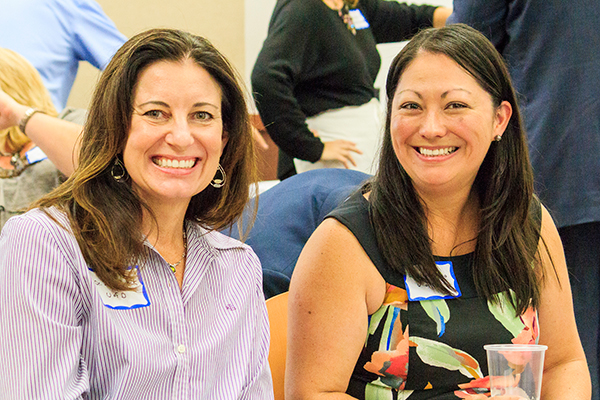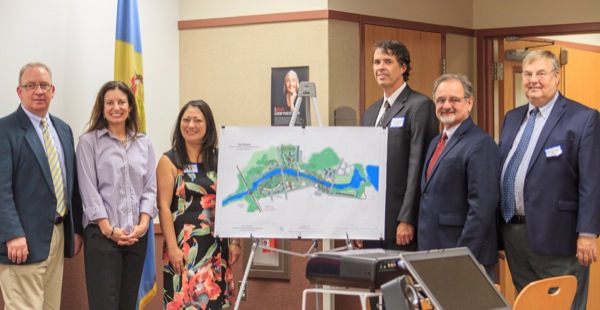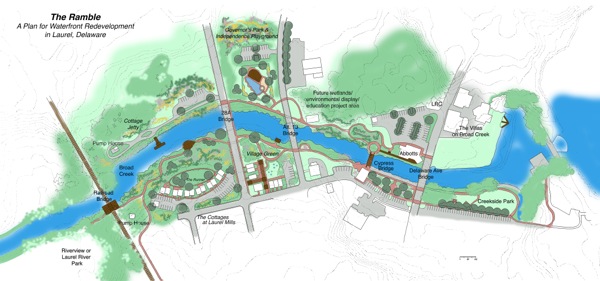'Ramble' on
UD researchers, students work on plan to revitalize Laurel
9:31 a.m., Oct. 8, 2014--An interdisciplinary University of Delaware research team has joined forces with the citizens of Laurel, Delaware, to map out a plan to revitalize and provide specific landscape design recommendations for the town, specifically the waterfront area along the Broad Creek.
The project is known as “The Ramble,” and features a large walkway that will extend the length of the town and includes six major development projects.
Research Stories
Chronic wounds
Prof. Heck's legacy
The idea came about when Ed Lewandowski, Delaware Sea Grant’s coastal communities development specialist who had been working with the town on implementing water quality mandates in the river as a part of a regional effort to restore the Chesapeake Bay watershed, discovered that the town was also interested in coming up with a master plan to re-develop the Broad Creek waterfront.
He got in touch with Jules Bruck, associate professor of landscape design in the College of Agriculture and Natural Resources (CANR), who worked through the summer with Lorelly Solano, a doctoral student in urban affairs and public policy, to develop and finalize the plans.
In addition, students from Bruck’s computer-aided design (CAD) class helped spur the project proposal on by studying and presenting examples of small town revitalizations to help flesh out viable and environmentally friendly options for the space.
Bruck put a proposal together for the Laurel Redevelopment Center — a private, nonprofit organization that works to support economic development in the town, located alongside Route 13 in Sussex County — and Lewandowski held focus groups to learn what the community wanted, as it was important for the team to come up with a proposal that pleased the citizens of Laurel.
“We really loved the idea that we were having a great collaboration between this not-for-profit, three colleges at the University, undergraduate students and members of the community of Laurel,” said Bruck.
Bruck is a member of the CANR faculty and Solano is studying in the Institute for Public Administration, a center in the School of Public Policy and Administration in the College of Arts and Sciences, while Delaware Sea Grant is housed in the College of Earth, Ocean, and Environment.
The group presented drafts of the plan to the Delaware Department of Natural Resources and Environmental Control (DNREC) Planners Technical Advisory Committee (PTAC), which offered advice on the plan and how the group could undertake modifications to make it more ecologically sound.
In fact, Bruck said that halfway though the project PTAC was able to provide an updated 100-year flood plain map to help the group revise its plan to accommodate for flood plain restrictions.
Also, Troy Mix, a policy scientist in Institute for Public Administration and a member of the American Institute for Certified Planners, looked at the ideas and offered his opinion about the direction the group was taking.
“We were proposing a housing development and park and playground, a new block of mixed used homes, or mixed use stores with houses above -- sort of like a mixed block community that you’d see in downtown Newark, with people living above the stores,” said Bruck.
The proposal also used ecological landscaping as the main conceptual framework to revitalize the small town using green infrastructure such as vegetated bioswales —used to remove pollution from surface water runoff — as well as the planting of thousands of trees and the installation of permeable parking surfaces that will allow water to infiltrate through instead of having the storm water run off the surface.
“We have some of these at UD, actually, and they are very beneficial for water quality. It seemed especially appropriate for Laurel, where we are dealing with a creek running through town,” said Bruck.
The team also looked at how to brand and market Laurel, particularly in the ecotourism market. Input by the citizens of Laurel showed they also were interested in having people come to the town to live and be part of the community.
The planners learned that while having a tourism aspect was important, it was also important to market the town to future community members.
“A lot of small towns do get a bit of a revitalization kick if they have an artsy community and people come on the weekends and go to the art fair and then go home, but Laurel is really interested in having people come there and live there and be part of the community,” said Bruck.
The group was able to conduct an interview with a UD student from Laurel to get their perspective on the town, such as what it was like growing up in Laurel and if they would move back to figure out how to encourage others to move there.
Project collaboration
Bruck said she thinks the collaborative nature of the project led to the community members agreeing with even some of the potentially controversial aspects of the plan, such as proposals to retrofit houses to become cafés with apartment living upstairs, and adding new buildings, a new pedestrian bridge and an underpass below the existing railroad bridge.
The ideas were met with little resistance when the project was presented to the community at a Laurel town meeting.
“We had such a diverse audience -- there were state legislators, the mayor, the school superintendent, community members, contractors, environmentalists -- and nobody had any objections,” said Bruck. “At the end of the meeting there was a long pause after I asked for questions and one woman said, ‘I can’t believe you put into the plan everything we vocalized during the focus group. I couldn’t understand how our words would ever get translated into a landscape design and you have done it.’ I think I owe the success of the project to the real collaborative nature and just being honest about the process.”
Mix, who provided advice on the market feasibility of the proposed design, offered reflections on the public presentation, saying, “I feel honored to have played even a tiny part in the project. I've not seen a public forum end with the kind of positive reaction I saw -- definitely the mark of a well-executed process and inspiring to witness.”
Next steps
Bruck and Lewandowski will travel to Laurel on Oct. 22 to present the proposal at a Rotary Club meeting and talk about the plans moving forward.
The first phase of the project would be a large infrastructure construction program in which everything would be put in place for the walking system, such as the pathways, lights and benches.
Also involved in the first phase of the project would be the installation of a Can-Do park that can be used by people of all abilities in a lot where the town has its Fourth of July festivities. Because of the location, the park is tentatively named Independence Playground.
Bruck said the Ramble is the backbone of the design and that “it will make a big difference in the town. Right now, I think there is a lack of connectivity in the downtown area and I think it’s going to make a real difference in the way the community perceives the space along Broad Creek. It’s a very exciting project.”
Article by Adam Thomas













